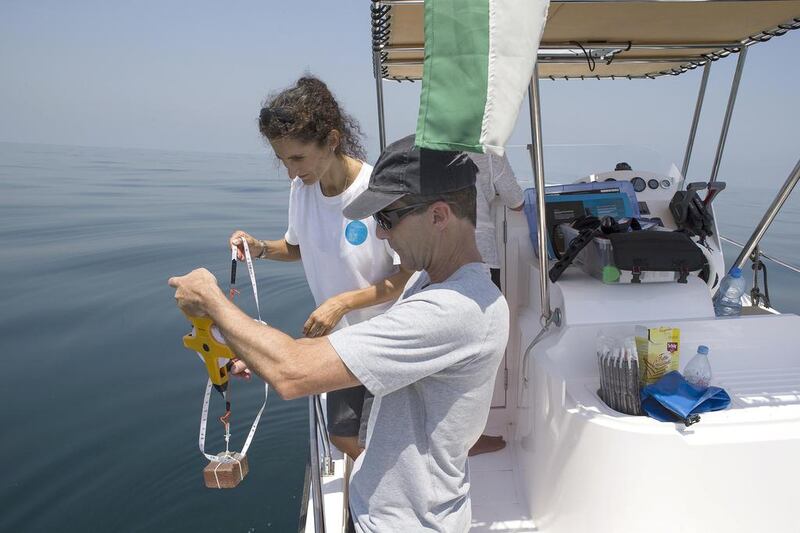Barely a minute had passed since Brunella Capitani started explaining the decision to volunteer for a Dubai-based research project when she abruptly stopped.
“Something at 10 o’clock,” she said, her eyes fixed at a distant spot on the horizon, her arm extended to a point left of the bow of the motorboat.
“I did see something glisten,” confirmed Mike Lawrence who, like Ms Capitani, had spent the morning scanning the surface of the ocean of Dubai’s coast for signs of life.
Piloted by Ada Natoli, the woman behind the research and conservation effort, the boat slowly approached, eventually allowing the crew a view of two large marine turtles in courtship.
While fascinating, the sight was not what the four-member team was after.
Dr Natoli, the founder and project coordinator of the UAE Dolphin Project, has been studying Dubai’s coastline for the marine mammals since December last year and already had data from more than 20 research trips. With years of experience in the Mediterranean and South Africa, she started the project so she could estimate the size of the dolphin population living in or visiting Dubai coastal waters.
Dolphins are what scientists call indicator species. As top predators, they are easily affected by disturbances in their food chain, and studying the size of dolphin populations helps to provide “a snapshot of the whole marine ecosystem”, she said.
Studies of dugongs in Abu Dhabi, during which dolphins were also counted, showed a decline of 71 per cent between 1986 and 1999. But Dr Natoli hoped her research would provide more detailed and reliable answers.
To do that she has been recording all dolphin sightings during trips in three areas off Dubai’s coast. The surveys were carried out on days when the sea was calm, with the boat travelling at a speed of no more than 10 knots (18.5kph). The route of the surveys followed a specific pattern, which was why Dr Natoli navigated the power boat with one hand, holding a global positioning device with the other.
With the help of volunteers such as Ms Capitani, a 45-year-old freelance tour guide, and Mr Lawrence, 56, who worked in education, Dr Natoli logged each sighting into her expanding database, recording the time, the co-ordinates of the spot, the species, number of animals, their behaviour and presence of any calves or juveniles within a group.
Also on the boat was Jessica MacAleese, 23, a freelance photographer who had been putting her professional skills to use, taking pictures of the dolphins. This was important for efforts to identify individuals, which was possible by carefully looking at the shape and marks of the dolphins’ dorsal fins.
Dr Natoli has already been able to identify 35 dolphins, with clear pictures of their dorsal fins. Of those, two dolphins had been re-sighted, who were first seen in April last year and later in October.
Identification and repeated sightings of individuals could also offer information about the size of the population – in a small, resident population, for example, over time the same individuals would be seen again and again.
While seeing wild dolphins was an enjoyable activity, Dr Natoli cautioned against members of the public who were overly keen on pursuing the animals. Approaching to within less than 50 metres of the animals could disturb them, she said.
In contrast with an earlier trip when about 40 dolphins were seen, Sunday’s six-hour journey did not yield any sightings.
But the trip saved a juvenile Hawksbill turtle, which was found struggling on the surface, its carapace covered in barnacles. The animal was captured and taken to recover at the Dubai Turtle Rehabilitation Project.
The research will continue until December, with Dr Natoli also continuing to collect data of dolphin sightings from members of the public. Those wishing to contribute can visit www.uaedolphinproject.org.
She was also looking for sponsorship to expand the scope of the work, engaging volunteers in more scientific work.
“The target we have is to make the project self-sustainable,” she said. “Otherwise it cannot go on for much longer.”
vtodorova@thenational.ae





